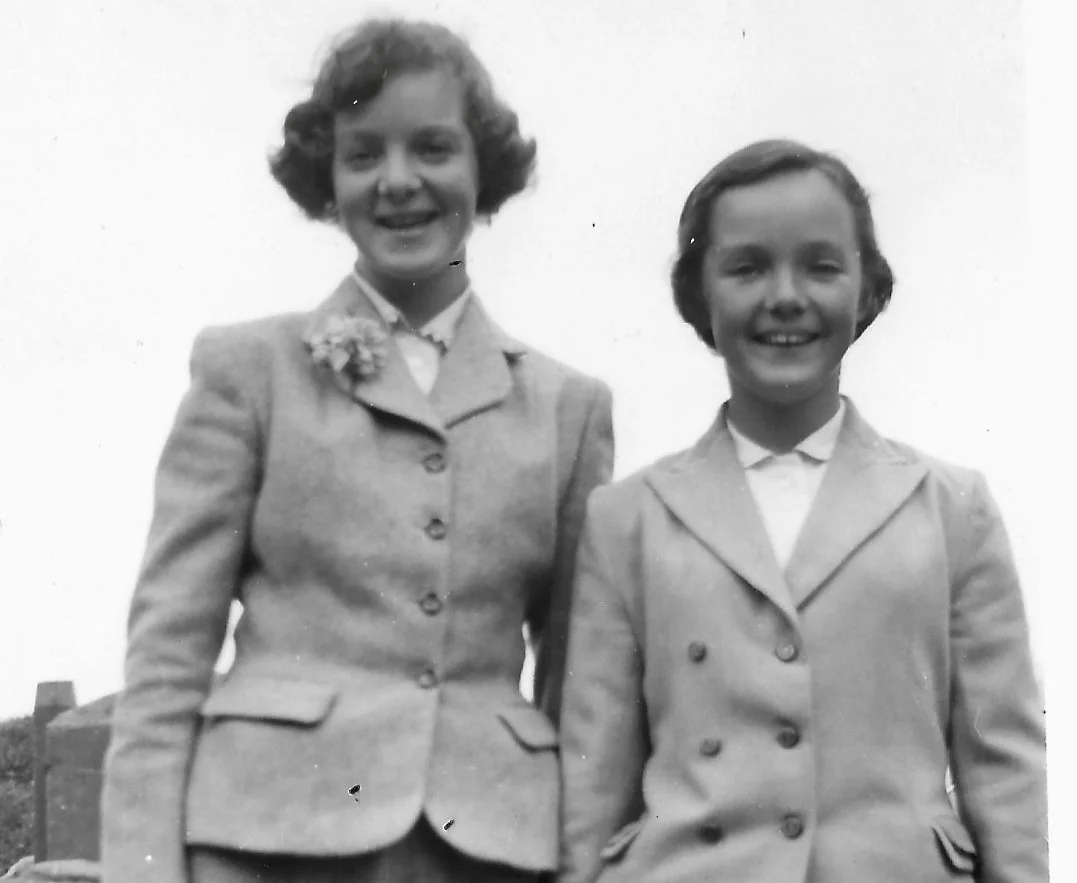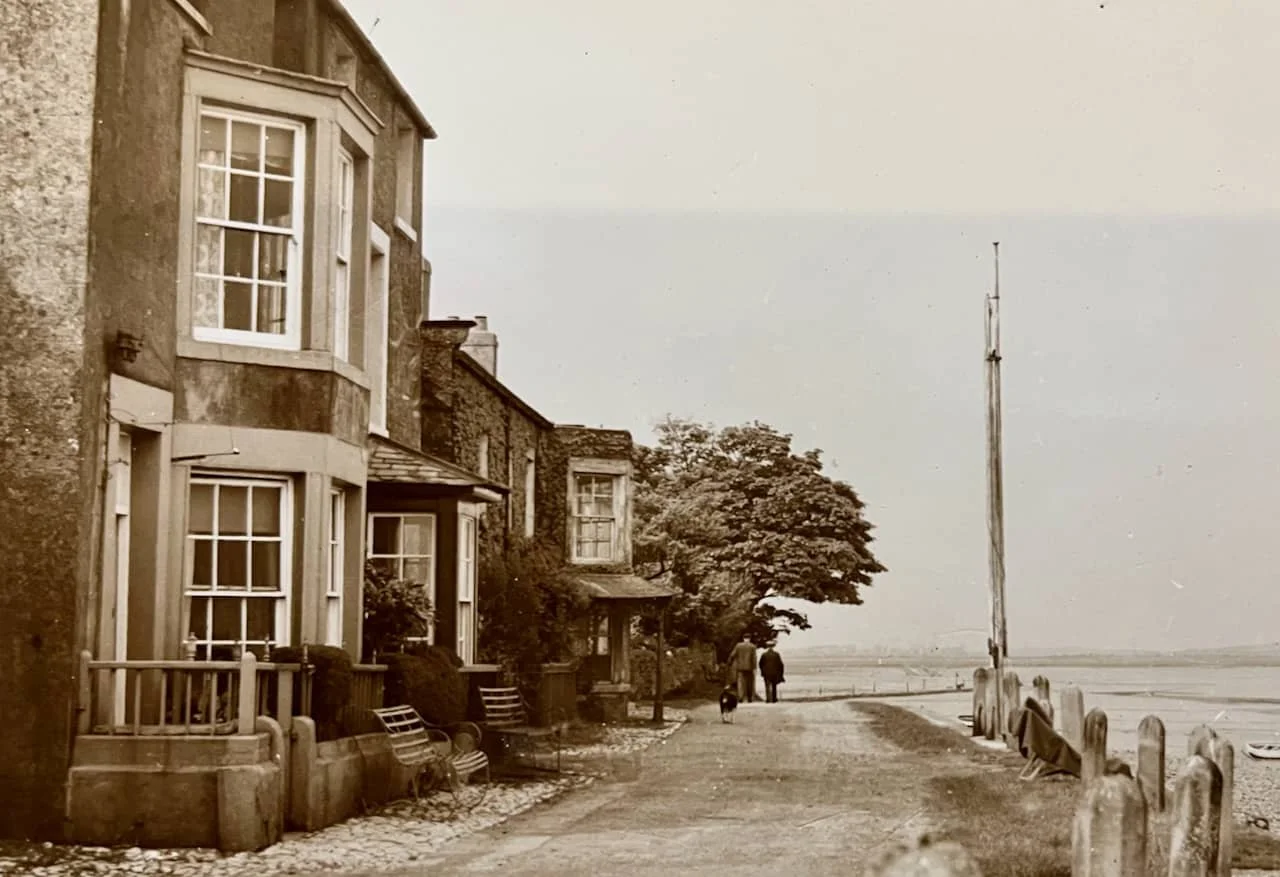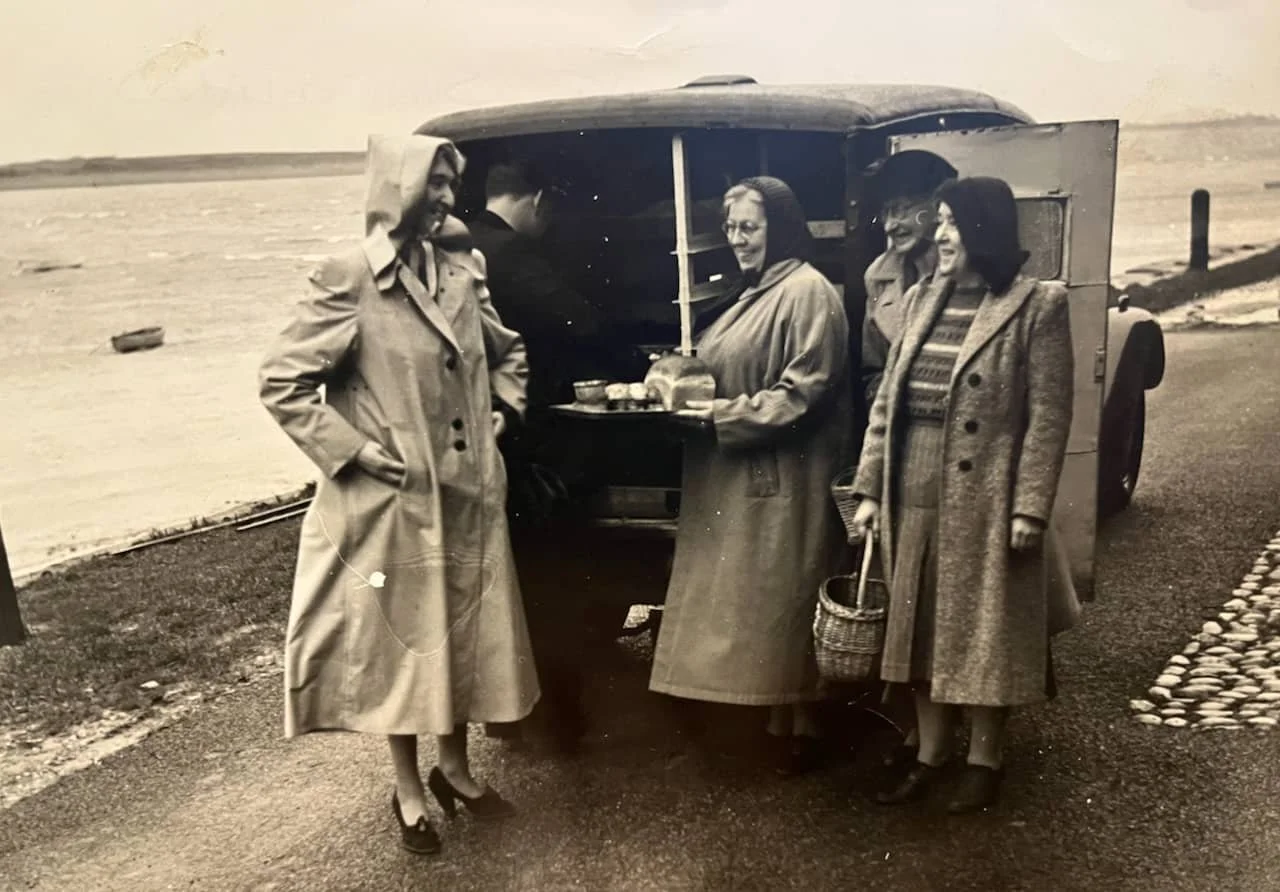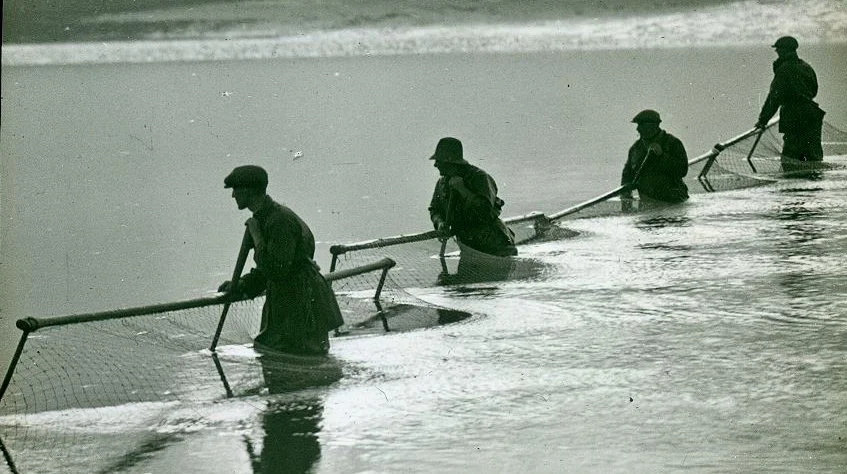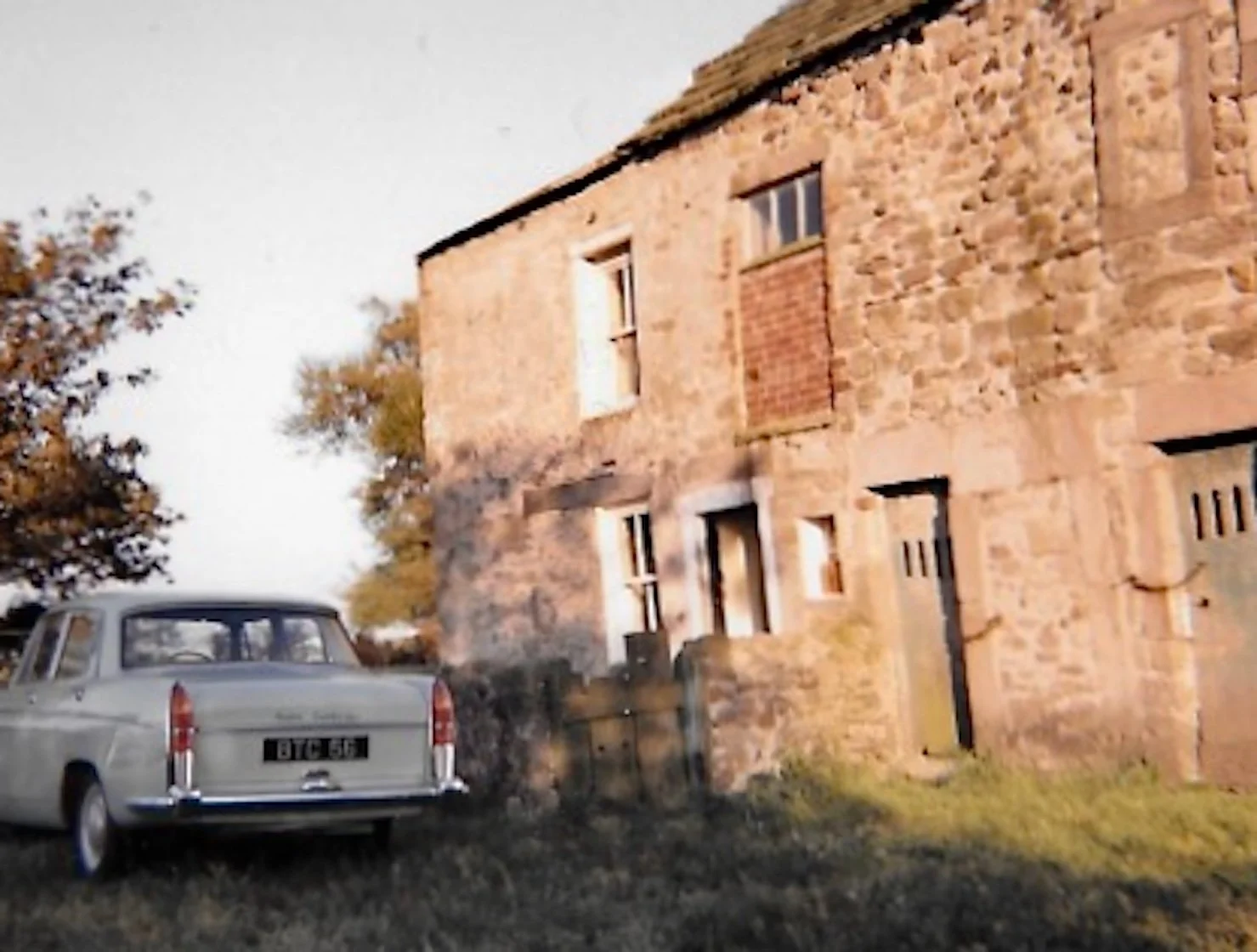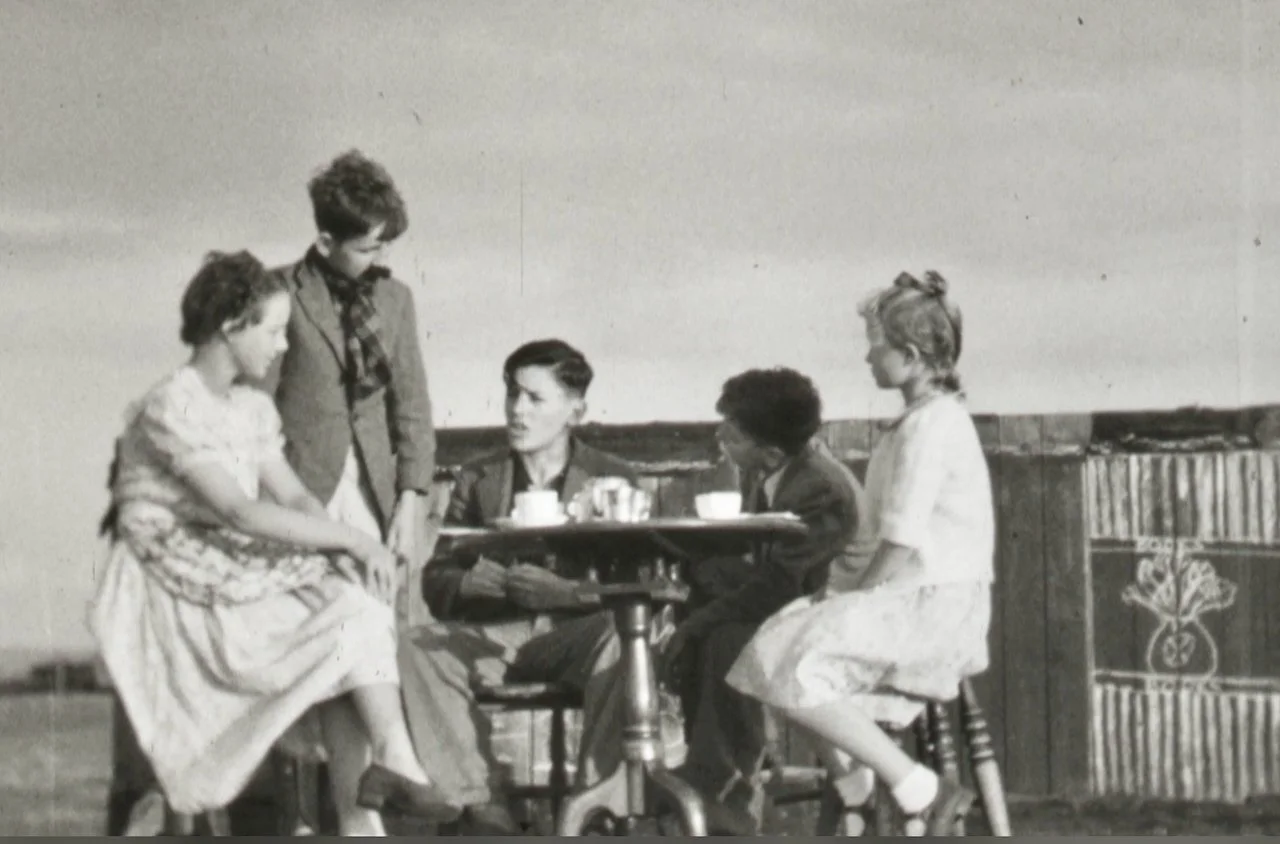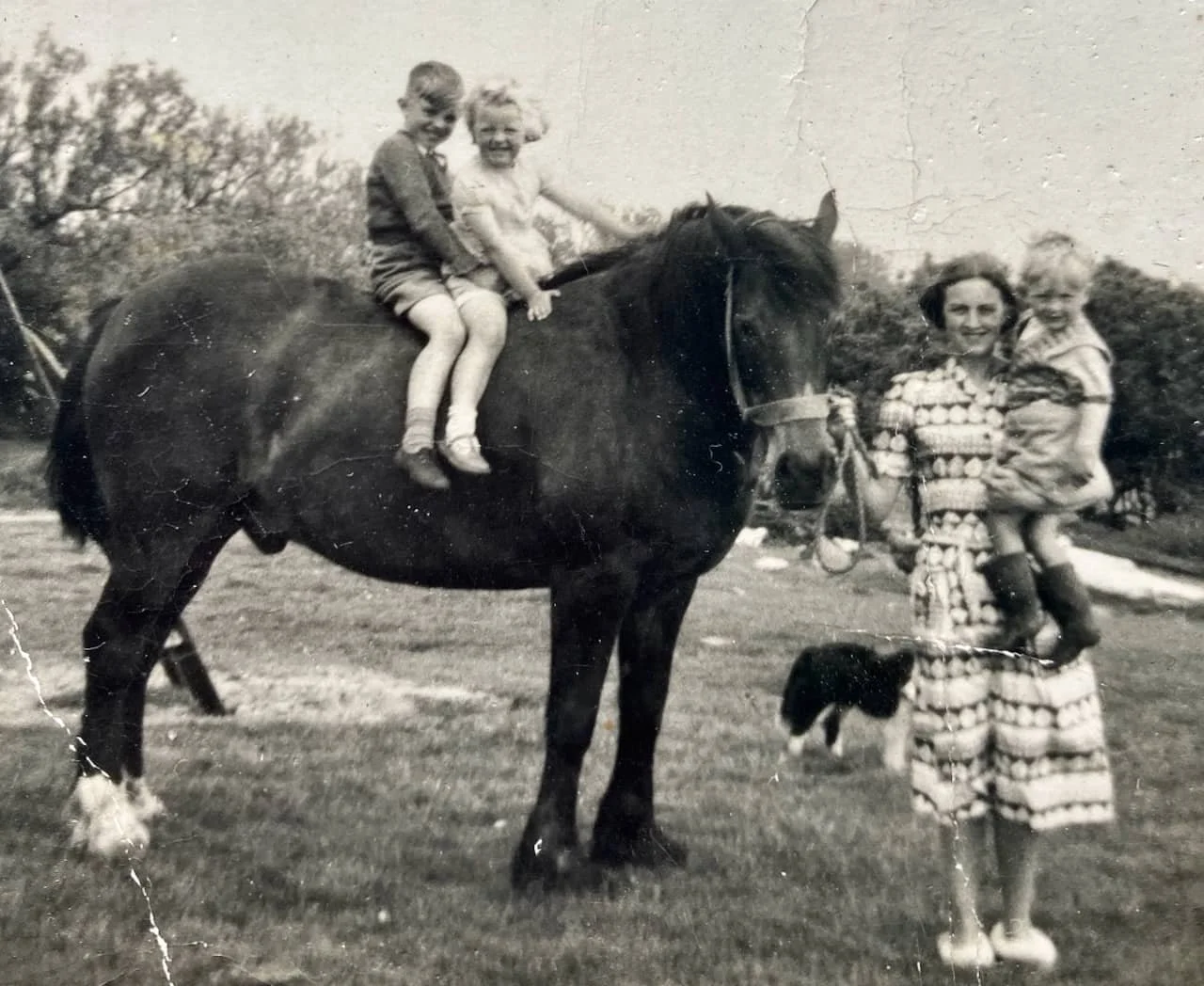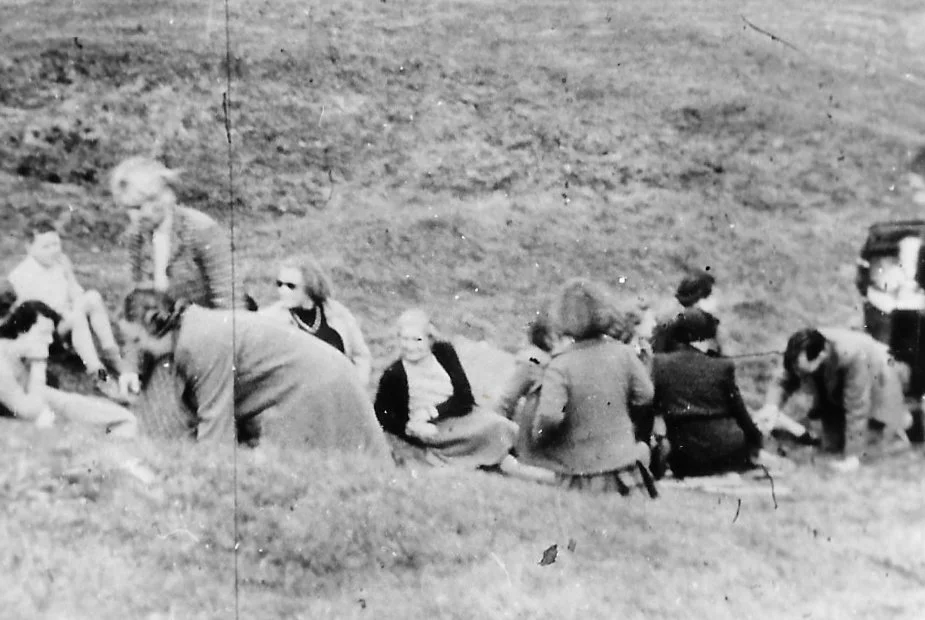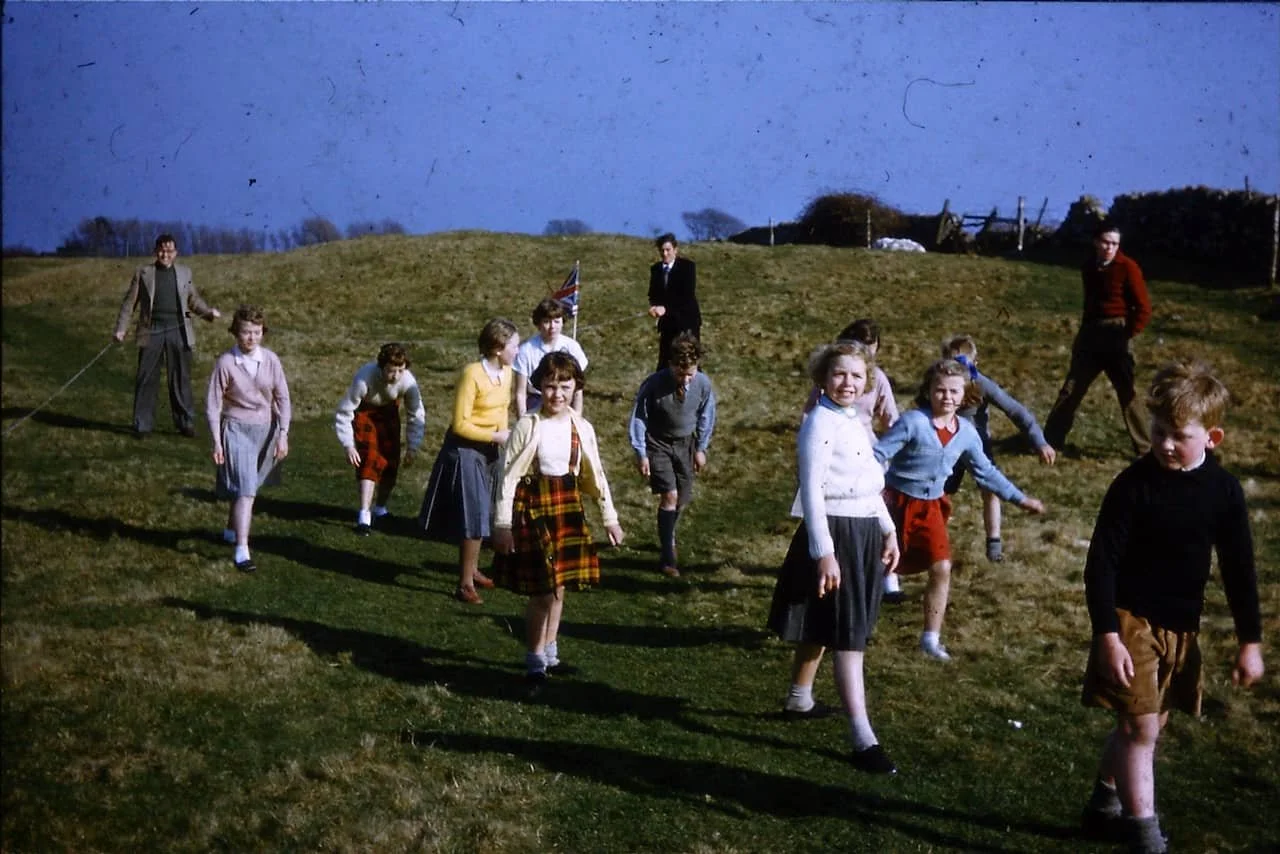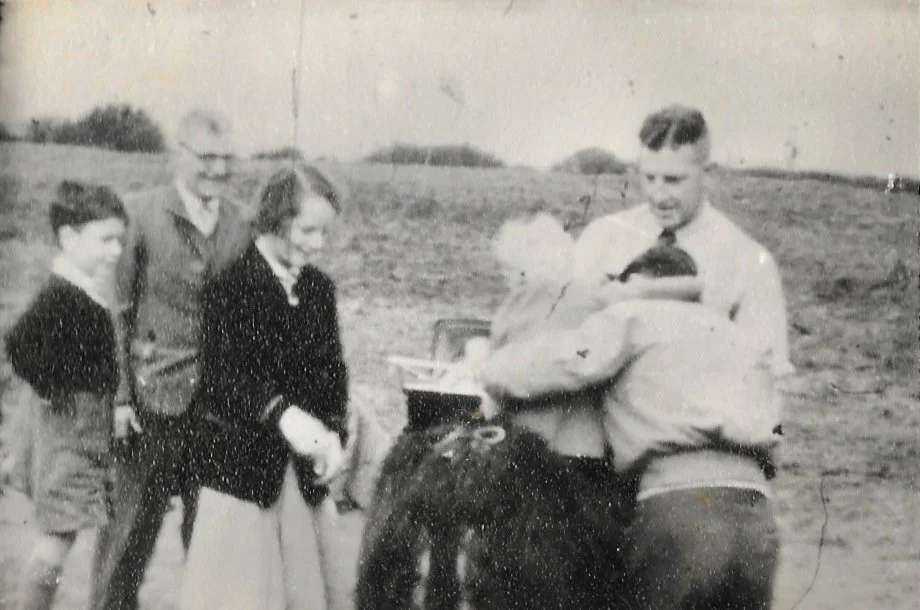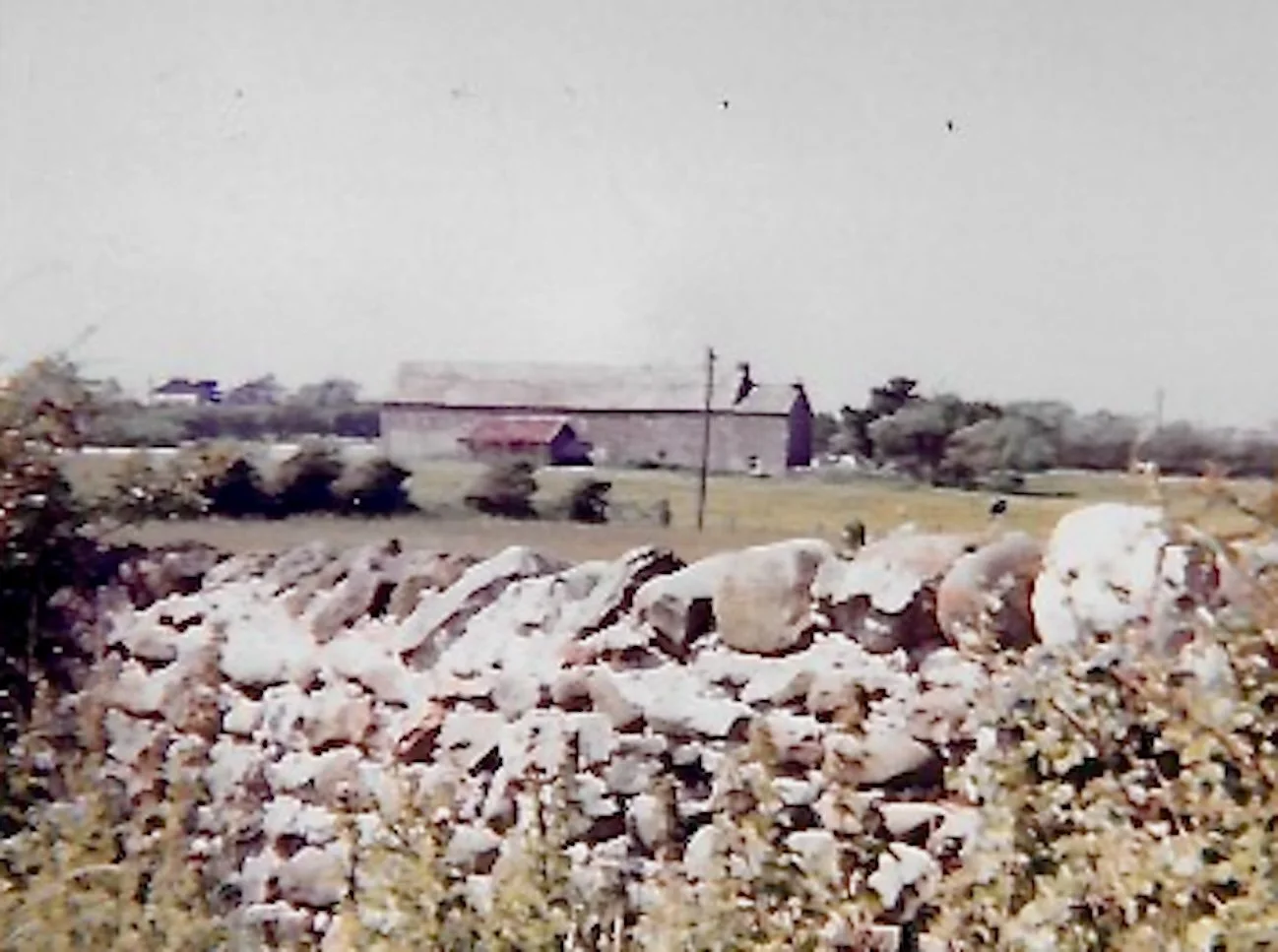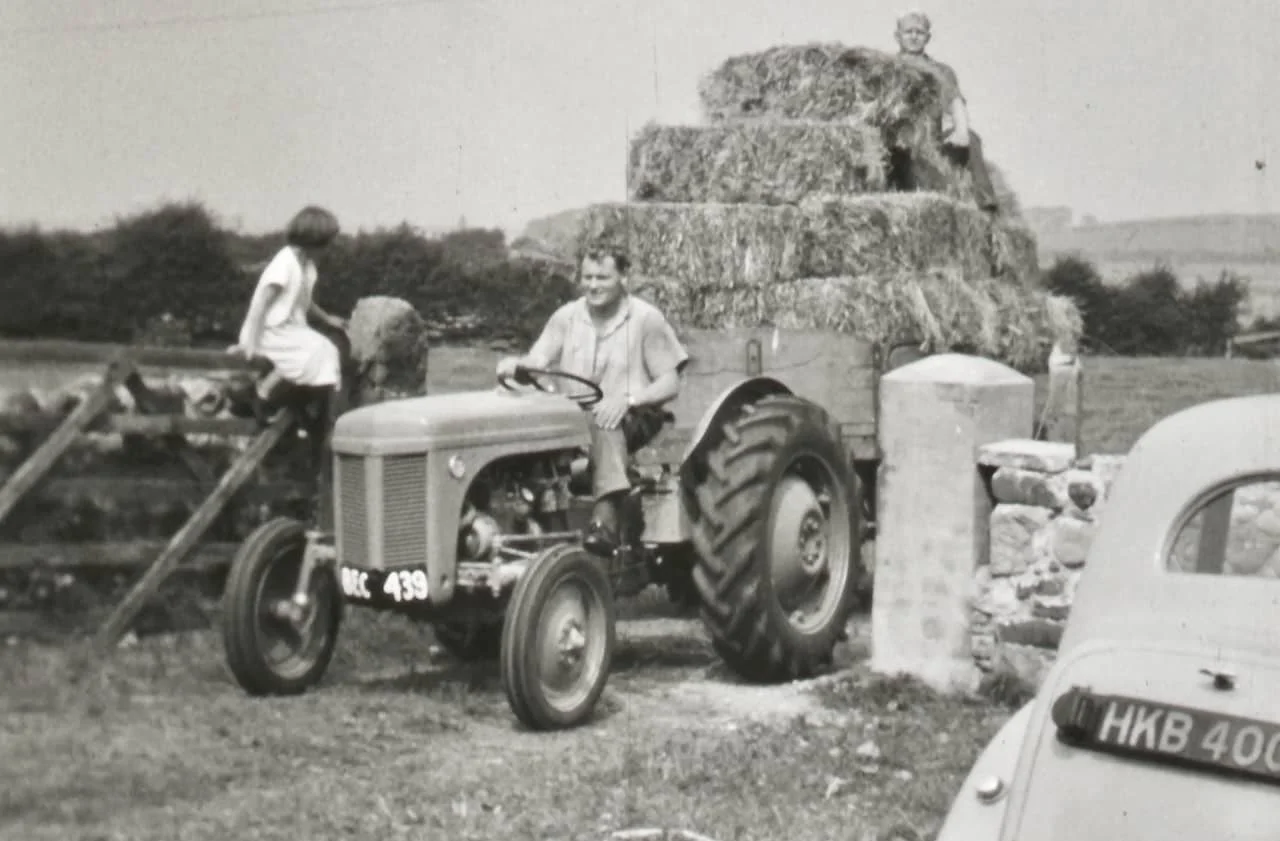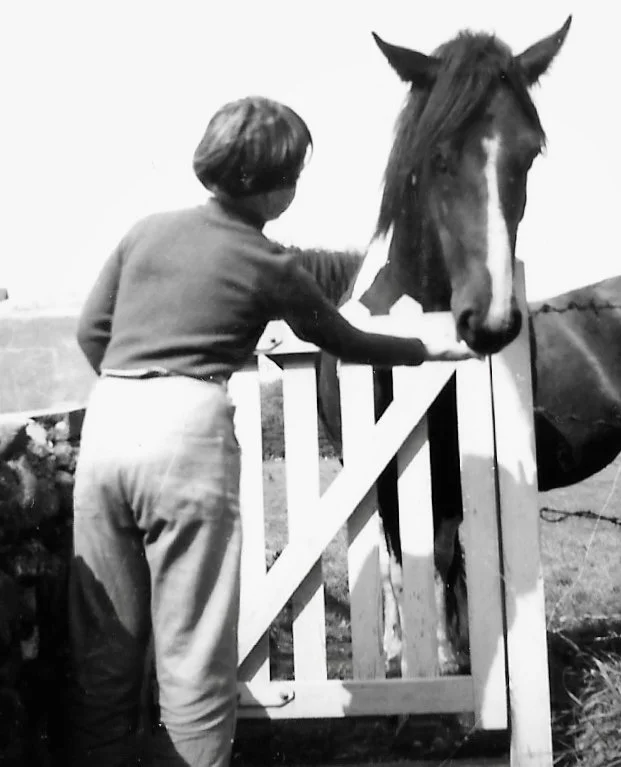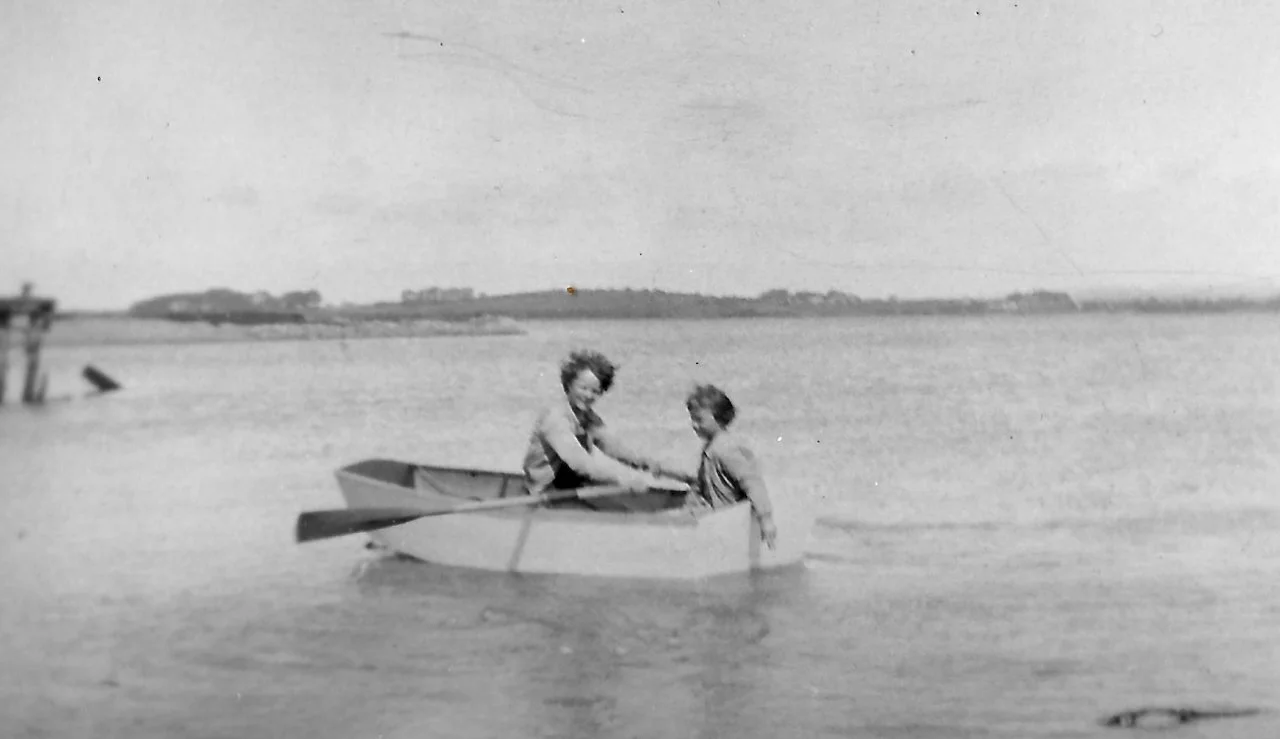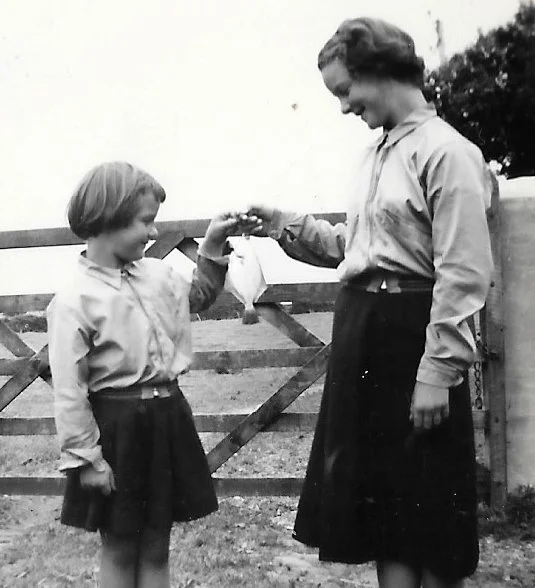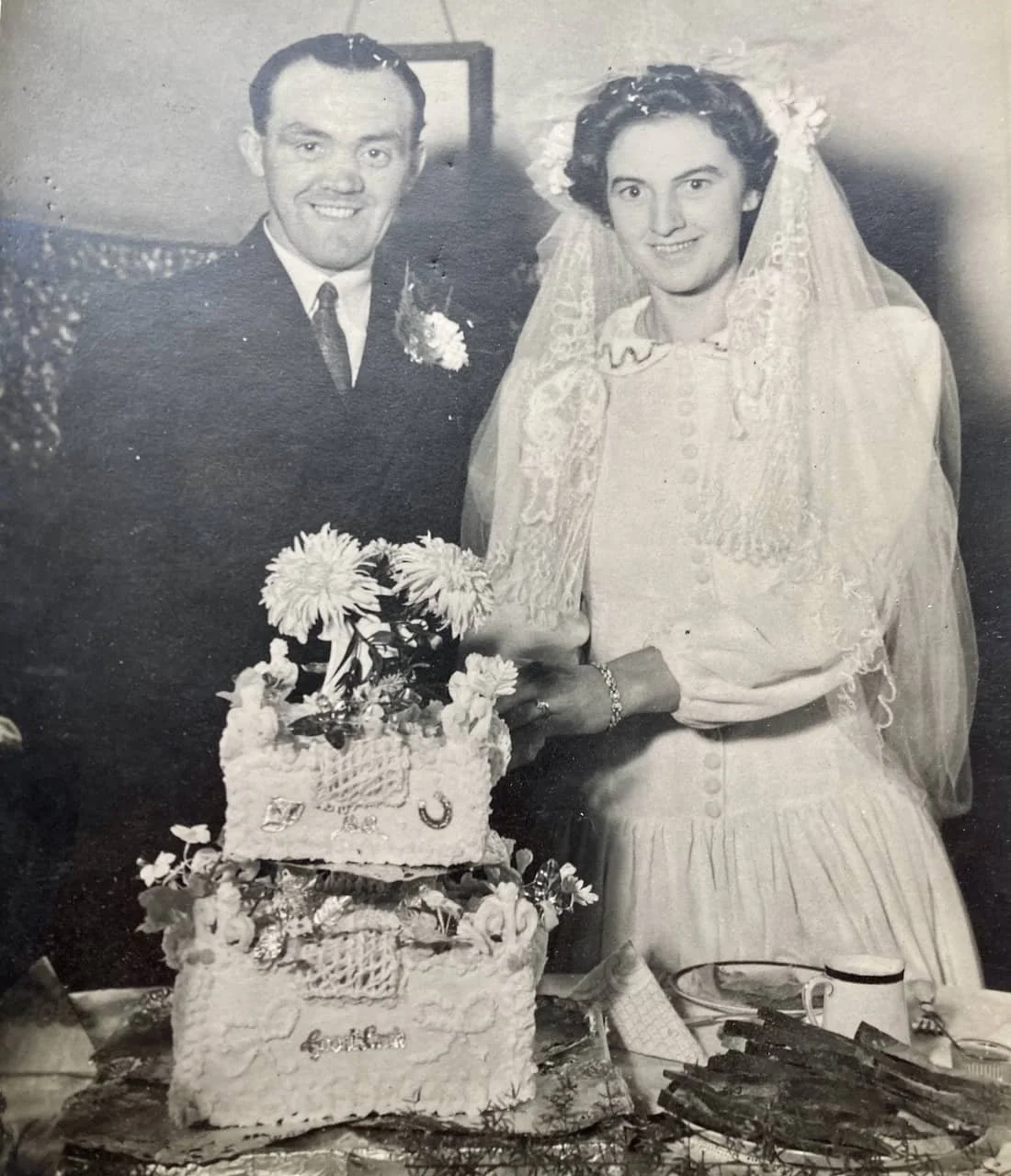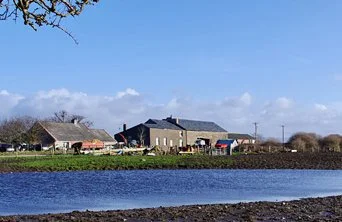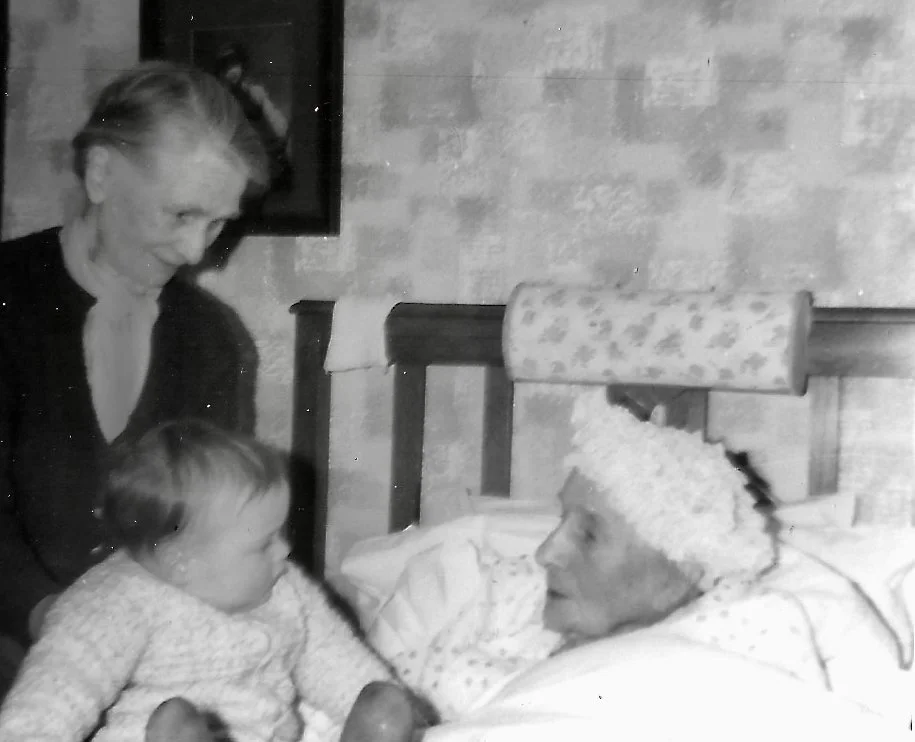Pat and Wendy
Memories of Sunderland Point in the 1950s
Pat and Wendy (right) Gerrard c1956: Collection Wendy Crockett
My first memories of Sunderland Point are of the inside of Gravelly (2 First Terrace), which, when I was very young, was the home of my great aunts, Clara and Ada Gerrard, retired school mistresses. They were born in 1865 and 1869, respectively when Disraeli and Gladstone were rivals for office and Queen Victoria’s reign had over 30 years to run.
Gravelly
Gravelly was furnished with items from their much larger family home in Liverpool and ornate mahogany wardrobes and heavily framed religious scenes crowded the small rooms. The dining room door opened with a quiet swish from the dark drape of a draught excluding curtain and behind it was an out of tune piano (which we weren’t allowed to play). When my sister and I were allowed into the sitting room, we had to perch on the horsehair stuffed chaise longue and behave ourselves. The porch was full of geraniums; to this day, their scent evokes that house to me. I always loved the staircase, with its wide, shallow steps and long window. It had china ornaments, sickly looking boys and girls with complicated wreaths of flowers and drapery, on the ledges at the side.
The best place though was the small front bedroom in which my sister and I slept when we stayed. It had a half-poster bed with a very soft mattress, which made you feel like a character in a story and there was a print of Holman Hunt’s painting, The Light of the World, at its foot. And, magically, from the small sash window with its acorn-shaped blind pull, there was the sweep of the tide and the ebb and flow of seabird song, never to be forgotten.
Auntie Clara and Auntie Ada
I scarcely remember Aunty Clara, who died when I was very young, but apparently, her nephews regarded her as the fun-loving aunt. Aunty Ada, whom I remember well, was a good deal more aloof. She was very fortunate to have a housekeeper, Nellie Jones, who had begun as a maid of all work with the family in Liverpool when she was very young. Nellie somehow coped with all the inconvenience of a cold and draughty house with no mod cons, the periodic storm damage and the lack of transport.
Ada Gerrard and Nellie Jones outside Gravelly: A Peter Hall Photograph
Visitors were ushered into Ada’s presence with some style; she was, after all, a Victorian woman and could be severe. I stayed there on my own once and was sharply reproved for putting my elbows on the table; ‘all joints on the table should be carved’, not that she meant to be unkind, just to ensure that I was well brought up. I’m not sure why I was there on my own, but think it might have been to do with quarantine from one of the childhood illnesses which were a good deal more dangerous in those pre-vaccination days.
Cars leaving the Point, 1960s – Gravelly in the background. A Peter Hall photograph
As we became more familiar with the village, Pat and I were rather disapproved of as being unladylike in our activities and clothing. Not only did we hang about the farms but it was even rumoured that we had been seen out in a boat with fishing youths. Ada was over 80 when I first remember her but was still vigorous; she worked energetically in the garden, digging the potato crop and pruning the gooseberries. Gravelly had an orchard and a good kitchen garden. I remember how the scullery smelled of stored apples.
Dr Maurice Denby lived on First Terrace and was some kind of retired academic. He made a daily visit to Gravelly to pass the time of day. Pat and I once listened at the door to their conversation. Dr Denby was remarking on the encroachment of ‘esparto grass on the archipelago’; this struck us as very pompous and funny. Although Ada could make critical remarks at his expense, it was clear that this daily contact was helping to keep her mind active, well into her 90s and when he died suddenly, she quite soon began to become confused.
Number 8, known then as ‘End House’ with the single bay window between 7 and 9. Dr M. Denby, a retired headmaster from Bradford, lived here. Clara and Ada owned number 8 between 1915 and 1940. Collection Hugh Cunliffe
I once counted the number of permanent residents of Sunderland in the 1950s when I first knew it and there were about 60. I loved the place so much that I wrote a long essay in school about it, which would be fascinating to read now, but unfortunately, it has long since disappeared. What follows are just my recollections, beginning from when I was 5 or 6 years old, so inevitably they will be faulty and I apologise in advance for any mistakes.
Sunderland Point in the early 1950s
Life was not easy in the early 50s for those who lived by fishing or farming at the edge of the Irish Sea. There were few cars at the Point but a couple of delivery vans came with basic groceries I think. There was a post office up the lane and a tiny little sweet shop on Second Terrace. Rationing had only just finished and it was a great treat to Pat & me to buy a small bar of chocolate.
The Grocer’s Van 1960s: Collection Hugh Cunliffe
There was a shop in Overton and of course milk and eggs came directly from the farm. The blacksmith still shod horses in the forge of the Ship Inn and each of the three farms (as they then were) had a working horse, though by the early 50s they were mostly semi-retired. There were also several working fishermen, Mr Townley, the Gardners and Bert Smith, (Tom and Alan’s father) who lived with his wife, Mary and their family in the little house on Second Terrace called ‘Multum in Parvo’, a most appropriate name. They went salmon fishing or whammeling in the white boats with red sails. They also carried on the ancient practice of ‘haaf’ netting and there was a (no doubt apocryphal) story of a day tripper, seeing the fishermen standing with their framed nets on both sides of the river, being told that there were men all the way across, some of them under the water.
Haafing in the River: A Sam Thompson Photograph, courtesy Lancashire Archives
It was apparently bad form to ask whether the catch had been good; I remember an occasional visitor who was a bit of a wag, seeing Mr Townley passing with a long round object wrapped in newspaper under his arm and commenting on the ‘nice stick of rhubarb’. Shrimping was done, either from boats (I think) or from behind a horse and cart and I remember seeing the women shelling them in the room underneath Upsteps at the bottom of the Lane.
Meadow Cottage
Meadow Cottage 1960s: Collection Wendy Crockett.
My father had loved the place since childhood when he and his brothers spent happy holidays with his indulgent aunts, who allowed them to mess around on the West Shore and go out in the fishing boats. In 1953, my parents succeeded in achieving their dream of renting a cottage. Meadow Cottage was in a very dilapidated state, having been the home of a Captain Smith, who seems to have had a fondness for the bottle, judging by the empties scattered in every room of the house.
I was taken to see the place and announced that I would never, ever go there; it was covered in cobwebs and great ugly nails had been knocked into every surface. However after my father spent a few weekends with some friends cleaning up and decorating, it was considerably more appealing, though only passed as fit for holiday accommodation as there was no electricity and we had only an Elsan(chemical) toilet. Of course, for my sister Pat and me, having candles and paraffin lamps was all part of the holiday fun; the down side was washing up (our holiday chore) and scrubbing the calor gas blackened pans with a Brillo pad.
Temperance Farm
We got our milk from Chris and Connie Hargreaves (the parents of Margaret and David), who were then the tenants of Temperance Farm. They lived in the old Temperance Hotel at the end of First Terrace and kept hens in the yard and paddock behind. In the little shippon they milked about 8 shorthorn cows which grazed the small field up the Wint and the fields on the left-hand side of the Lane, running down from the church to Sambo’s Grave. It was 15 acres in all and it must have been very hard indeed to make ends meet for a small family on so little.
I will never forget the first time that I was sent to ask Chris for some milk. I was 8 years old and extremely shy. I must have stammered out my request but didn’t understand a word of his reply; his lovely North Lancashire accent was completely unfamiliar to a little Liverpudlian. It wasn’t long though until a visit to see the milking was the highlight of my day and I quickly learned to love the mild mannered red and white cows and to know them all by name, June and Rosie and the rest.
Wendy with ‘our friend Lucinda’: Collection Wendy Crockett.
I suppose holidays like ours would be impossibly tedious to a modern child. We had no TV and only a small radio and a few books for entertainment at the cottage but we had the luxury of being allowed to roam about as we liked. The Hargreaves’ farms were always the biggest draw.
Entertaining ourselves
Tom Hargreaves, Chris’ brother, was still living at Sunderland Brows in the early 50s and he and Nora had three children, Honora, Veronica and young Tom. There were also various cousins who sometimes stayed in the holidays. Pat, my sister, was roped in to help put on a play which was performed, to general merriment, on top of the concrete wartime lookout on the West Shore. As the youngest member of the troupe, I was given the job of prompter. We have recently been able to digitise my father's cine film, which records this memorable performance.
Scene from the play on the pillbox, a still from the restored cinefilm: Collection Wendy Crockett
We also loved the daily trip along the West Shore to deliver the churns of milk to the collection stand at Middleton, hanging off the back of the cart with our legs dangling as the tractor bumped up and down through the potholes. Sometimes the day started with us joining Chris and little Margaret at Temperance Farm.
Maggie, with Tom and Margaret Hargreaves on top, Connie to the side with David: Collection Hargreaves family
Maggie, their horse, was hitched to the cart and we all went off down the Lane, the brambles snatching at Margaret’s little woolly cap as she shouted, ‘no go Yebbie’. This was a reference to her great aunt ‘Rebbie’, as she was known, to whom Chris paid a duty call when he took the milk to Middleton. Margaret was frightened of her for some reason.
Egg Rolling
The highlight of Easter visits was of course the ‘egg rolling’ or ‘Pace egging’. Perhaps this still carries on; if not, it’s a great shame as it’s an ancient custom.
Egg Rolling: Collection Wendy Crockett
Egg Rolling in the Grave field: A Peter Hall photograph
Everyone boiled eggs as hard as they could – people had their own secret recipes – and coloured them. I remember that Connie did hers with cochineal. On Easter Monday, the whole village gathered in Sambo’s Field and competed by rolling their eggs against each other, with a prize for the hardest egg. There were also races and a picnic.
I also remember Mr Hall from the Old Hall bringing his son Robert’s pet donkey, called Pepper, which would give rides to the children if it was in a good mood.
Egg rolling, Mr Hall and Pepper the donkey: Collection Wendy Crockett.
Coronation Day 1953
We were at Meadow Cottage on Coronation Day, June 2nd 1953, but as the cottage had no electricity, there was no radio. We didn’t have a television at home anyway, so didn’t feel deprived. The local residents were invited in by the Gilchrists at the Dolphin House to see the broadcast, though it can’t have been easy to see much, given the size of screens in those days. My chief memory of the day was that my dad completed a wooden style he had made from the field behind Meadow Farm over into the lane, and carved the date on in. Unfortunately, it has long since disappeared
Bonfire Night
We were once at Sunderland for Bonfire Night when there was a great communal bonfire on the West Shore – no shortage of wood of course. Nora Hargreaves made some delicious treacle toffee which made her husband speechless for a while; his false teeth had completely bonded together.
Meadow House Farm
Meadow House Farm from the Lane 1960s: Collection Wendy Crockett
By and large though, as I said, we roamed about. Meadow Cottage was still part of Meadow Farm and formed the end of a long stone barn. The barn, mostly empty, had cow stalls which had a platform above them, exactly like a stage. Pat sang alto in the school choir and taught me the soprano line so that we could sing duets to the dusty rafters and the rats (which were unfortunately plentiful).’Lead me Lord’ and ‘All in the April Evening’ were our party pieces. The farm itself was no longer a separate unit but was used by Harry Birkett from Hall Farm on Second Terrace.
Harry Birkett
Harry Birkett bringing hay from Meadow Farm Fields, Wendy on the gate: Collection Wendy Crockett
Harry prided himself on being up to date and he ran a herd of pedigree Friesian cows. The heifers were grazed at Meadow Farm and occasionally, much to our excitement, they would calve unexpectedly and we would have the drama of running to tell Harry. We once went with Chris and his family to a farm sale at which Harry bought a bull, called Cedric. It was housed in a shed (now a house I think) beside the cotton tree. Outside the shed was a stone on which I could climb and with Pat’s help, peep through at the massive animal through a little window. However, the best thing was that Harry’s elderly carthorse, Lile’un, was out to grass with the heifers at Meadow Farm. She was a veteran of many casual farmhands, not least the Irish lads who used to turn up in the Summer to help with the hay, and for whom Lile’un was the taxi to get them to the Globe or the Ship at the end of the day. She would return at the gallop; fortunately for any driver who had overindulged, she didn’t need anyone to show her the way home.
Harry once had a local Overton boy, Harry Capstick, working for him. Harry was not really enamoured of farm work, being much more interested in a new pop singer called Elvis Presley. His boss was highly amused about a song Harry liked about a Teddy Bear. I once watched Harry trying to get Lile’un, pulling a hay rake, through the gate onto our lane. The horse didn’t like gateways but would go through if you were sufficiently firm; alas for Harry, he lacked the air of authority and he couldn’t get her to budge. In the end, he unhitched her, led her through the gateway and pulled the rake through himself. I swear she was laughing. For me, Lile’un was the pony I had always longed for. She had got her name because she was exceptionally small for a heavy horse, about 14-15 hands I suppose. She was tolerant of being led around and groomed and even allowed me to ride on her very ample back. I was heartbroken when we arrived one day to find that she had died suddenly in her field.
Wendy with Prince (Tom Smith’s horse) and Lile’un behind: Collection Wendy Crockett.
Around the Point
On the shore in front of Meadow Farm was a beached barge. It must have been there many years as it was in a very dilapidated condition, but we could still climb on it and imagine we were out at sea. On the very few days when it was warm enough, we would take deck chairs down there and watch the tide, and the foolhardy visitors who decided to ignore the warnings at Overton and chance their cars with the rising tide. Dad was keen that we should learn to respect the sea, so he got us a small rowing boat and taught us to use the oars. We were allowed to go on our own on the relatively sheltered beach in front of Meadow Farm but if we ventured round in front of First Terrace, it was on the end of a rope which he held on the shore.
On our own. Pat and Wendy out boating: Collection Wendy Crockett
We were also allowed to swim in the same area, well away from the most treacherous currents. It was muddy and freezing and probably pretty insanitary, but who cared? One of the big changes which has taken place is that the marsh to the left of the road (facing Overton) has become covered in vegetation; in those days, it was mainly mud flats.
Our Catch. Wendy (left) with her sister Pat. Collection Wendy Crockett
If all else failed we would do the walk round the Point and along the West Shore, looking for anything interesting on the tide line. You could sing ‘Ten Green Bottles’ as you counted the empties and see whether you could find any discarded holiday items washed round from Morecambe. Our most dramatic find was a tin of syrup which exploded when we opened it. Then you could visit Sambo’s Grave and read the funny inscription with the s’s like f’s.
It’s touching to see that it is now a place with far more meaning to contemporary children – not that we were untouched by Sambo’s sad fate but we had heard that it was rumoured to be ‘nobbut an old ‘orse’. Everywhere there were birds we never saw at home in Liverpool. In the fields around the cottage, lapwings were a common sight, frantically distracting you from their flimsy nests in the grass during the breeding season. It’s hard to believe they are now a threatened species.
Going to Church
On the Sundays when the tide allowed, there was a church service in the afternoon, for which we had to dress in our best.
Going to Church. Pat (right) and Wendy in their Sunday best c1956. Collection Wendy Crockett
Climbing over the wall at the top of the Lane was tricky when we became teenagers and wore nylon stockings. Tom Smith rang the church bell; you had to try to get there before his family had arrived, otherwise he would stop and the vicar would begin. There was a rather squeaky harmonium and a member of the congregation who sang half a bar ahead of everyone else but for me, no Easter service will ever quite equal those in the little brick church smelling of daffodils, everyone in their unaccustomed Sunday best.
The Mission Church: Photo Alan Smith
Sunderland Brows Farm
But above all, there was the farm. Sometime after David was born, when Tom Hargreaves and family moved to Middleton Brows, Chris and Connie took over Sunderland Brows. There we would spend as much time as we could, ‘helping’ with the milking and no doubt getting in the way and being an awful nuisance. Even so, Chris’s easygoing nature and unfailing patience and kindness meant that we were never made to feel this. We loved the milking time when he would be there in his old woolly hat (on the rare occasions when he took it off, his forehead was leprous white), singing the old music hall favourites, ‘Come, come, come and make eyes at me, down at the Old Bull and Bush’ and handling his cattle kindly and calmly so that there were never any dangerous incidents in spite of there being children everywhere.
Wedding photo of Chris and Connie Hargreaves: Collection Hargreaves family
As well as John and Margaret, there was cute, blonde little David, always smiling. At the end of each afternoon we would come away with the milk can overflowing with a generous Hargreaves measure and often a ‘dozen’ eggs from Connie that always somehow turned out to have two extra when you got them home. We cajoled Chris into letting us name the new calves and feed them sometimes. In those early days they were still growing a field of oats which were harvested with a reaper and binder and stacked for threshing. Chris cut the reeds from the farm’s ditches and thatched the stack roof himself. He had a fund of stories of the old days and his childhood when he would fall asleep in Overton School because he had to get up and milk (by hand) before going to school.
Sunderland Brows Farm: An Ian Taylor photograph
Wartime had brought soldiers to Sunderland which must have been fun for the young lads though alarming for some. He remembered a soldier teasing an elderly resident by demanding ‘Who goes there?’ and getting a very flustered ‘Phoebe Townley’ in reply. He and his cousin would cycle to Morecambe on Saturday nights for the dances and when he met Connie, he would think nothing of cycling to her home in Burton in Lonsdale. He and Connie were unfailingly generous and hospitable and I owe them an enormous debt for the many happy hours I spent at Sunderland Brows. Even when I had left home and was a student, Connie would write wonderful letters which read exactly as she spoke, full of news of the farm and the neighbours.
Leaving Meadow Cottage
By the time that I left school in 1963, my parents had given up Meadow Cottage and our holiday visits came to an end. However, Aunty Ada and Nellie continued to live at Gravelly and in 1969, Ada celebrated her 100th birthday. The flag was raised on Second Terrace in her honour.
Sadly, she had outlived all her nephews but Pat and her husband, now living in Lancaster, were able to visit with one year old Robert, Ada’s great great nephew. She was bed ridden but still looked after by Nellie, herself in her 70s. She lived on until after her 101st birthday in 1970.
Nellie Jones holding Robert with Ada Gerrard: Collection Wendy Crockett
The Flag on Second Terrace, in honour of Ada Gerrard’s 100th Birthday. Photo Peter Hall.
We are grateful Wendy has permitted us to publish this important and nostalgic memoir. We send sincere thanks.
